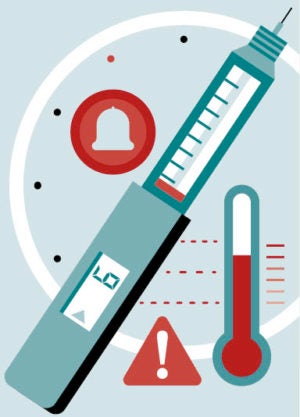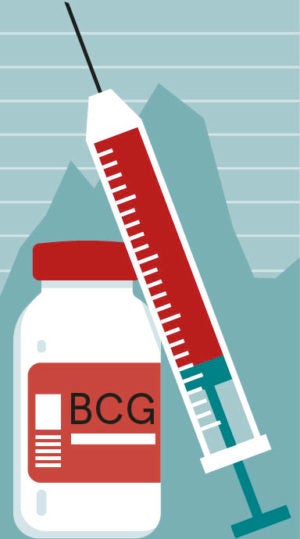What are the challenges innovators face? A person with diabetes cannot process sugar or glucose properly and glucose is the body’s main fuel. Insulin, a hormone produced in the pancreas, normally allows glucose into each and every cell of the body, but people with type-1 diabetes cannot produce insulin, while those with the type-2 form of the disease produce sub-standard insulin.
Diabetes occurs when excess glucose stays in the blood instead of being taken up by the cells. Therefore, the innovative challenge is to balance insulin administration with glucose control and take account of changing insulin needs. For example, exercise requires glucose to fuel muscle. This can cause blood glucose levels to drop, leading to reductions in the need for insulin. Here are five innovations aiming to improve the lives of people with diabetes.
01 Continuous glucose monitoring

The traditional way to monitor blood glucose levels is with a finger-tip prick blood test. Many people with diabetes have up to ten tests a day; that’s 70 times a week, 240 times a month and up to 80,000 times in a lifetime. These are on top of multiple insulin injections.
Inevitable loss of sensitivity in fingers can have a massive impact on quality of life and discourage regular monitoring. Only 30 per cent of people with type-1 diabetes achieve their glucose targets, according to the NHS National Diabetes Audit.
Traditional monitoring has another major downfall. It only provides a snapshot picture at one point in time. In contrast, continuous glucose monitoring (CGM) with a small sensor inserted just under the skin of the stomach or arm can record blood glucose levels every five minutes.
A transmitter sends the readings to a smart device such as a mobile phone and also sounds an alarm if the glucose number is below or above a certain threshold. CGM systems even allow individual users to invite up to five people to follow them, providing an additional safety net and peace of mind for family and friends.
The hallmark of future developments is poised towards miniaturisation with sensors packaged in products resembling bandages to increase comfort for users, but also direct connection with smart insulin pens or pumps to facilitate or even automate insulin injections.
02 Insulin smartpens
Insulin injections used to involve large needles that had to be sharpened by hand and sterilised before the correct dose was drawn up carefully from a small bottle or vial. In 1982, the Penject became the world’s first commercially insulin pen, thanks to the determination of a Glasgow doctor, Sheila Reith, to find a more accurate, less painful and more convenient way to give insulin to her young daughter.

The Penject was the precursor of today’s insulin smartpens. For example, the recently launched In-Pen also combines the technology of a smartphone with the simplicity of a traditional insulin pen.
It can be linked to an app that will be available for both iPhones and Android devices. At present, it is restricted to Apple iOS 10 and later devices. The app displays your active insulin, blood glucose (via pairing to your continuous glucose monitoring device) and last insulin dose. It also reminds you when to take a dose, calculates and recommends your next dose, and warns you if your insulin has expired or is too hot or too cold. Data can be shared with healthcare professionals.
The first Bluetooth-connected smartpen to be approved by the US Food and Drugs Administration, the prescription-only In-Pen, is not yet available in the UK.
03 Artificial pancreas
The bionic or artificial pancreas marks a major advance in the development of insulin pumps for type-1 diabetes, arguably the biggest innovation in the field in the last 50 years. It closely mimics the glucose-regulating function of a healthy pancreas and includes a continuous glucose monitoring system and an insulin infusion pump.
The first pumps were launched in the 1970s as an alternative to injections. Today’s battery-operated, pager-sized models, with their fine micro-needles, provide regular insulin 24/7. The insulin flows via a tiny tube or cannula inserted under the skin. This can be left in for two or three days before it needs to be moved to a different injection site.
The difference between standard pumps and the new artificial pancreas is said to be the equivalent between a conventional car and a driverless one. In a Diabetes UK-funded trial of a prototype bionic pancreas involving 24 people, the bionic testers spent 13.5 per cent more time with their glucose levels in the right range, compared with those on standard therapy.

One trialist, Mark, told Diabetes UK: “I felt I was on holiday for the whole month. Waking up almost everyday with blood glucose levels in target range was something new for me and gave me a sense of stability I just don’t get using the insulin pump.”
In 2016, the US Food and Drugs Administration licensed the Medtronic 670G, making it the first commercially available artificial pancreas for type-1 diabetes, with a so-called hybrid closed-loop delivery system. In June, it was approved for use in Europe.
Nikki Joule, Diabetes UK policy manager, says: “We anticipate that the artificial pancreas will be marketed in the UK before the end of this year, but availability for individuals on the NHS will depend on local funding arrangements and criteria. There will be some people for whom this is the most clinically effective solution, but it will not be the right technology for everybody.”
In one of the first such type-2 diabetes trials, reported this year, bionic users spent almost 25 per cent more time with blood glucose levels in the target range, compared with subjects relying on injections.
04 Diabetes vaccine
One jab of the BCG tuberculosis vaccine followed by a booster four weeks later has been found to restore near normal blood levels in patients with type-1 diabetes. The effect has lasted for more than five years.
Type-1 diabetes is an auto-immune disease in which the body’s immune system turns on itself. BCG has been known for more than 30 years to induce a response that could prevent an auto-immune reaction.

05 Cell regeneration
This September, a patient in Queensland, Australia, was reported to be the first in the world to receive a new drug to treat type-1 diabetes. The patient was the first of eight volunteers in a trial. The hope is that the drug will help to regenerate insulin-making beta cells. Success would make patients less dependent upon injections and less vulnerable to long-term complication of diabetes.
01 Continuous glucose monitoring

02 Insulin smartpens


